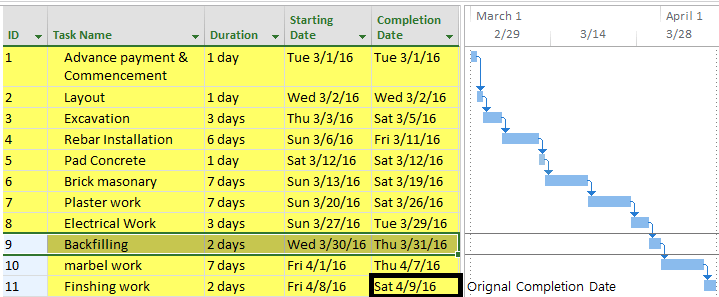INTRODUCTION
Project Managers and Construction Managers around the globe always resist Changes and Additional work in the Projects, however, Changes, additional works, or delays often find their way into the Project. Whenever a delay occurs, the Contractor has to evaluate its impact on the Project timeline and cost. Here we will discuss a method to evaluate the impact from the perspective of the timeline.
The most common method that is used in the industry to determine the impact of delays on the timeline of the project is named TIA (Time Impact Analysis). As an outcome of performing TIA on your Project, you will get to know the change in the End Date of your Project. Once you know the number of days your Project gets delayed, you can start working on the additional cost evaluation to be claimed from the Employer but we will leave this topic for another article. Let’s move towards the most simplified guide to performing TIA analysis on your Project.
PREREQUISITES TO PERFORM TIA
There are certain things you should know before we move toward performing the TIA on your Project.
LIST OF ALL DELAYS
There can be many delays that have impacted your project. It’s advisable to make a list of all these delays. These delays will later be called “Fragnets” when we add them to the project schedule. If Fragnet is a new word for you, then memorize it, it will come in handy for you to understand TIA entirely.
OBTAIN THE RECENTLY UPDATED AND APPROVED SCHEDULE
TIA should be performed on the most updated schedule of your Project, i.e., the schedule before the occurrence of delays. This schedule shall be duly approved by the Client or the Client’s representative. It’s imperative to mention that this schedule’s activities are properly linked, i.e., successors and predecessors are properly assigned in the schedule. Furthermore, the calendar settings are approved by the Client. This schedule might have some free float/buffer available which will absorb the delay to the extent it can.
PERFORMING TIA STEP BY STEP
Here is the guide to performing TIA step by Step.
INSERT FRAGNETS INTO THE SCHEDULE
In our most simplified example, we will add three delays (Fragnets) to the Project. A Fragnet is added next to an activity that got delayed in the Project. Fragnet is added in such a way that its duration is “zero days” at the time of addition to the schedule. Fragnet must be properly linked into the schedule as any other activity in the schedule i.e., its predecessor must be the activity before it and its successor must be the activity next to it.
See the below picture. We have a simplified Project of 11 activities. The End/Completion date of the Project is 09 April 2016.

Now we are going to add three Fragnets to the schedule. These Fragnets represent delays reported in the following three activities, i.e. Excavation at Serial No. 3, Pad Concrete at Serial No. 6, and Electrical work at Serial No. 10.

There is no effect on the project’s End/Completion date as the Fragnets’ duration is zero days.
INCORPORATE DELAY DURATION INTO FRAGNETS
Now, we are going to incorporate the actual delay where it occurred. As an example, we suppose there is a delay of 4 days in Excavation, 5 days in Pad Concrete, and 7 days in Electrical work at Serial No. 10. We will put the duration of the corresponding fragnets in the duration column. You can easily see the brown Gantt Bars on the right side of the below picture.

You can clearly see the change in the End/Completion date of the Project from the originally set date of 9 April 2016 to 25 April 2016. The total delay is 16 days = 4+5+7.
EVALUATE THE CRITICAL PATH
As there is no float available in this example Project and it means that all the 11 activities in the Project are on the critical path. Any delay in any activity of the Project will delay the Project End/Completion date. If there was any float available, it will absorb the consequent amount of delay.
SUMMARY:
Performing TIA on Project enables the Project Manager to understand the impact of extra work, the number of additional resources required, and the new completion date of the Project. The results of TIA shall be communicated to the client as soon as possible.
If you have any questions about performing the TIA method of knowing the impacts of delays, additional work, or any changes on your Project, you can contact Leopard Project Controls.





